|
Chapter H The Horse 
own illustration Uploaded, final
In the history of warfare there is no nobler creature than the Horse. Whether hauling chariots, powering a cavalry charge, carrying supplies over harsh terrain, or running in and out of danger in the service of mounted troops, a horse brings strength and mobility that no minifig can match. Without the spirited assistance of these magnificent animals, history's greatest wars would consist of little more than a bunch of guys wandering around listlessly and bleeding. 
Every BrikVerse hosts a multitude of simultaneous apocalypses in various stages of progression, each with its own attendant Horsemen with their own attendant Horses. The Four Bikers of Ragnablok ride Rocket Hogs.
remove
In BrikWars, a Horse isn't any specific type of animal. Instead, it's a blanket category for any single-passenger steed or vehicle that's roughly horse-sized. A horse is a Horse, of course, perforce; but so is a gryphon, a motorcycle, a magic carpet, or a small-sized dragon. For players engaging in Horse trading, A Horse is equal in value to one minifig. The Horse's superior physical attributes are offset by its limited intelligence and its vulnerability to enemy hijacking.
 The Horse category is broad and inclusive. This CHKN Walker artillery support mech is a perfectly acceptable Horse.
image rights not secured
 When the Praetorians raised themselves back up to stellar empire status, they needed standardized Horse-equivalent vehicles for quick mobility. The Cougar quad-bikes did the job.
image rights: dilanski,
signed 1-10-21 A unit in the Horse category has roughly the same abilities that a Human would expect from real-world horse, and its Action, Move, and Armor attributes operate the same way as a minifig's. Common sense will dictate whether a given type of Horse can perform acts like swimming, Sprinting, climbing ladders, or hauling chariots. In the rare case where common sense is insufficient, a What I Say Goes Roll will clear up any confusion.
see 4.2: Action A Horse uses its Action for the same kinds of tasks a minifig would, as far as it's able. The difference between a Horse's Action and a minifig's is that a Horse is a Submissive creature and can only perform useful tasks while under a minifig's direction. When a minifig directs his Horse to take any Action requiring an Action Roll, the player rolls either the Horse's Action Die or the minifig's, whichever is lower. This spends the Action of both the Horse and the minifig. (In the rare case in which a Horse takes an Action of its own accord, only its own Action Die is used.) While being ridden or led, a Horse is completely obedient to its current minifig. If its minifig is killed, wanders off, or is otherwise absent, a living Horse remains under its current player's control until the end of that turn. If none of the player's other minifigs have managed to take control of the Horse by then, then the player must hand control of the Horse over to an enemy player of their choice. On the enemy player's turn, the enemy can direct the Horse to take either its movement or its Action - not both. If none of the enemy's minifigs have taken control of the Horse by the end of their own turn, the enemy must select one of their own enemies to take control of the Horse. The Horse continues passing from enemy to enemy each turn until some minifig manages to take the reins or the Horse is killed or otherwise removed from battle. Minifig weapons can be mounted on a Horse for their minifig riders to operate and fire. A one-minifig Tiny Tank, for instance, is a steel Horse with a Long-Ranged Weapon attached. Horses are not intelligent enough to use equipment items or operate machinery on their own. Instead, Horses rely on their ability to make unarmed Horse Attacks.
A Horse with hooves, teeth, claws, poison tentacles, or other weaponized anatomy is able to make one Horse Attack per turn. Where a standard horse-type Horse can deliver kicks or bites, more exotic Horses might employ tail stings, razor talons, or digestive pseudopods. The Horse Attack is roughly equivalent to a minifig's Hand Weapon, doing the Horse's Action Die as damage in Close Combat with a Use rating of 2. The Horse Attack is a simplified version of the Natural Attacks described in 10.3: Dangerous Beasts. Depending on a creature's anatomy, a Natural Attack can have a number of secondary effects in addition to (or instead of) doing regular damage, from Grabs and Shoves to Poison and Charging Weapon effects.
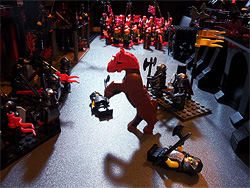 Forced into a show trial for a murder he didn't commit, Trotsky the Horse sees his chance to Shove off his captors and escape.
From "Rainbow War II: Jellybean Apocalypse" Elements shown: LEGO, Mega Bloks own photo Uploaded, final
Horses are bigger than minifigs, so they have the advantage in Grabs and Shoves. When a Horse Grabs another Horse, it works the same way as between minifigs: the Horses can no longer move or take Angry Inches, and Close Combat attacks on either of them are Automatic Hits. If a Horse Grabs or is Grabbed by a minifig, it's a different story. The Grab keeps the minifig from moving, but it doesn't slow down the Horse. A Horse can be reduced to Half Speed if it's in a Grab with two or more minifigs at the same time, but no amount of minifig Grabs can stop a Horse completely. A single minifig isn't large enough to Shove a Horse by himself. It takes two minifigs Shoving together to Shove a Horse. Horses Shove other Horses as normal. When a Horse Shoves a minifig, the minifig has a -2 Action penalty to his Parry roll.
see 4.1: Movement 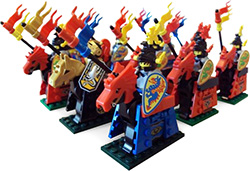 The illustrious Dragon Guard rides Heavily-Armored Horses in service to the Paladin Lucien Sylvanus, former apprentice to Majistik #5, Slayer of Dragons.
image rights: Rev. Sylvanus,
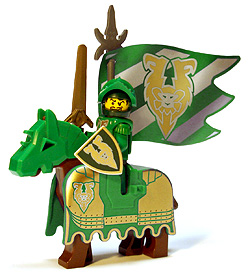 Sir IVascus the Monkey has invested in all the finest Horse equipment. During the events of Rainbow War II: Jellybean Apocalypse Gaiden, the horse was revealed to be Sir Stalin's horse Trotsky in disguise.
Elements shown: LEGO, custom graphics own photo Uploaded, final
For minifigs, Horses, and other animals, movement is an unrestricted affair. They can spend their Move inches however they like, running and jumping back and forth along any arbitrarily complex zigzag. Players may decide that a particular Horse may not be able to hop around as freely. It may be hauling a load, for instance, or wearing roller skates. These situations are left for the players to handle as they see fit. Like minifigs, a Horse running in a straight line can Sprint, spending its Action to add an Action Roll to its inches of straight-line movement. A Horse's Armor works in similar fashion to a minifig's: an attacker must do enough damage to exceed the Horse's Armor in order to have any effect. The difference is that a Horse takes two hits to kill rather than one. The first time that damage exceeds a Horse's Armor, attach a damage pip (usually a red 1x1 brick) to the Horse somewhere prominently visible to indicate that the Horse has been Wounded. When a Horse is Wounded, it's reduced to Half Speed, its maximum Momentum and Physical Opposition are limited to 1 MOM and POP, and its ability to Shove and Grab and to resist Shoves and Grabs are reduced to that of a regular minifig.
Players who are familiar with the MOC Combat rules will recognize these as the effects of reducing a Size 2" Creature to an Effective Size of 1" (7.2: Taking Damage).
Like a minifig, a Horse may be equipped with Body Armor or Heavy Armor to boost its defenses. Regular Horse Light Armor covers the Horse's body but not the head, raising the Horse's Armor rating to 1 
own illustration Uploaded, final
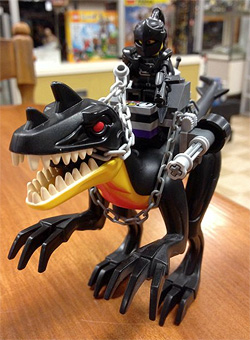 The Raptor Riders are the most intimidating units in the Army of JAM.
image rights not secured
Horses and minifig-controlled vehicles are more like very large equipment items than independent units. Controlling a Horse costs a minifig's Action, but depending on how many hands he's using to control the Horse, he can sometimes use other items already in hand at the same time. If a minifig elects not to use his Action for steering, or if the control systems are disabled or inaccessible, the default movement for an undirected Horse is to continue doing whatever it was already doing. The Horse moves in whatever direction it's facing at the same speed it was traveling on its previous turn. If the undirected Horse runs into an obstacle, it will leap or climb over it if possible (to a maximum height equal to the Horse's legs or wheels); otherwise it will be stopped and possibly cause a Collision (H.3: Fighting From Horseback).
While every minifig has the basic level of skill required to operate a Horse, few have the training and experience to excel at it. The Rider is an experienced horseman who moves as naturally on horseback as on his own two feet - and in some cases, even more so. Horsemanship Specialty: no-Hands riding 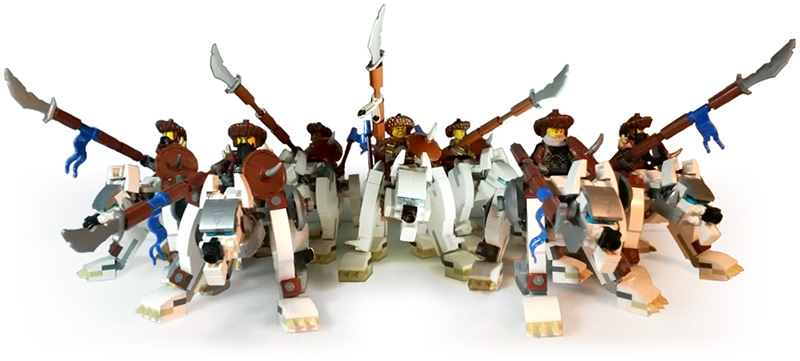
Frostborne's heavy cavalry mounts the great dire wolves that were once feared and hunted by Frostbornians.
image rights: Kommander Ken,
signed 7/23/20 The Rider's advantage is simple. Where lesser minifigs must use their Hands to steer, a Horseman's natural link with his steed gives him full control regardless of carried items or distractions. A true Horseman can operate a Horse blindfolded, standing on his head, and juggling chainsaws, whether it's him or the Horse doing the blindfolded juggling, or both. A Rider and Horse are treated as a single creature with all of the Rider and Horse's weapons. They can use any combination of their weapons to make a Ranged, Close Combat, or Charge attack on a single target. In Close Combat, a skilled Rider and Horse are so closely bonded that each can Parry and Counterstrike for the other. If a Rider on a Horse is targeted with a Grab, Shove, or KnockBack, he resists with the full strength of the Horse. A hit with a Heavy or Two-Handed Weapon doesn't Knock him Back or Disrupt him, and he resists Collisions with two dice of Physical Opposition. If an attack or maneuver is successful in Knocking him Back, it Knocks Back the Rider and Horse together as a single unit rather than unseating the Rider. When a Horse is acting under the direction of a Rider, it always uses the Rider's Action Die, regardless of whose is smaller. 
own drawing Uploaded, final
For most types of combat, making attacks from atop a Horse is the same as making attacks on foot. Minifigs on horseback check their weapon reach or range and make their Action and Damage Rolls exactly as usual. The two areas in which a Horse's increased size can make a difference are when it's the target of an Attack and when it's making a Charge. While a Horse and its minifig are often treated as a single unit, they're separate targets that can be attacked together or individually. If attacked together, the defending player gets to decide which of them takes the damage from any successful hits. A typical Horse is large enough to grant attacks a +1 Action Bonus for target size, whether the attacker is targeting the Horse and minifig together or targeting the Horse alone. Targeting the minifig specifically confers no Action Bonus, and might even suffer an Action Penalty if enough of the minifig is hidden behind the Horse to count as effective cover. Like a minifig, a Horse that Charges in a straight line for four inches builds up one MOM worth of Momentum (5.4: Charge!). However, because the Horse is twice as large, it can build up twice as much inertia. If a healthy Horse extends its Charge an additional four inches after that, it can build up a second MOM. (A Wounded Horse is limited to one MOM no matter how far it Charges.) A Horse's MOM s can be spent in the same ways as a minifig's MOM: adding +1 A Horse's higher potential Momentum increases its ability to send opponents flying. A Horse that successfully Knocks Back a target with one POP only loses one of its MOMs as a result, even if it delivered two MOMs' worth of KnockBack. It can keep its second MOM and continue Charging into more foes. A Horse's extra stability also makes them more resistant to getting Knocked Back themselves. A Horse resists KnockBack inches with two POP A Horse who's Knocked Back can be Disrupted if the KnockBack distance is greater than the width or length of the Horse from that direction. Because most Horses are longer than they are wide, it's easier to knock them over from the side (where they may be less than an inch wide) than from the front or the rear (where they're likely to be two inches in length or more). A Horse that's Knocked Back this distance or less simply lands on its feet and is ready to keep fighting as usual. A Horse that's Knocked Back further than its length lands on its side and is Disrupted. A Horse Knocked Back twice its length lands upside-down and Disrupted, possibly delivering upside-down Trample damage to its own passengers. If a Horse and a target are Charging each other at the same time, each makes its KnockBack roll by rolling its MOMs against its opponent's POPs as usual. This may result in one, both, or neither combatants getting Knocked Back, depending on the results of the rolls. Like minifigs, a Knocked Back Horse takes one point of Smash damage for each inch of KnockBack prevented by obstacles larger than itself. (Smaller objects simply get Knocked Back along with the Horse.) Minifigs are smaller than Horses, and therefore it's natural for Horses to want to stomp on them. Trampling is a means for a Horse to add insult to injury. If a minifig is lying on the ground Disrupted, possibly as a result of being Knocked Back by a Charging Horse, then the Horse can run over the prone minifig for one additional point of Trample damage. (A single point of damage isn't enough to kill any regular minifig, but, cumulative with other injuries the minifig may have sustained during the Charge, the final additional point can sometimes make the needed difference.) Any number of Horses can Trample a Disrupted minifig in a single turn, but each does its point of Trample damage only once. Running the same Horse back and forth over a minifig a dozen times is funny but has no extra effect. Horses do no damage to other Horses with Trampling, because they're the same size. Again, it's still funny to watch them run over each other regardless. 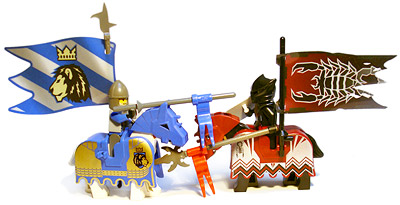 Only the most villainous of jousters aims to lance his opponent's horse instead of the rider.
Elements shown: LEGO, Little Armory own photo Uploaded, final
Minifigs don't wear seat belts. A minifig can lose his seating and fall off his Horse if he's Knocked Back, as a result of Something Bad happening when he or his Horse takes damage, or because of his own Critical Failure if the players decide it's an appropriate or funny consequence to inflict on him. Unless he has the Rider's Horsemanship Specialty, a single inch of KnockBack is enough to separate a minifig from his Horse and Disrupt him. Unless the KnockBack places him on some other part of the Horse, he falls off, and may suffer a Collision with the ground. If the Horse is moving fast enough to have Momentum, or if the distance of the minifig's KnockBack and fall is at least four inches, then he's treated as having one MOM and takes 1 If an unseated minifig is restrained in some kind of cockpit or crash cage, it can prevent him from falling off the Horse, but he takes a point of Smash damage for every inch of KnockBack prevented. If a Horse is Knocked Back, Disrupted, or killed, or if a minifig and Horse are Knocked Back together, the minifig can choose to either stay with the Horse or attempt to Bail. In either case, he's Disrupted afterward, and if the Horse lands on top of him he takes one point of Trample Damage. If the minifig rolls a Critical Failure on his attempt to Bail, he falls off the Horse. 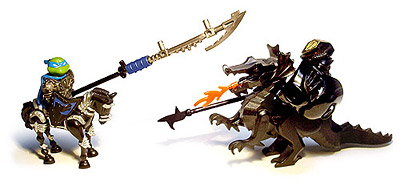 A Jousting unit with a smaller lance may feel the need to compensate with a more impressive ride.
Elements shown: Mega Bloks, LEGO, Little Armory own photo Uploaded, final
Jousting is the characteristic attack of the mounted horseman, and it combines the fun of a mounted Close Combat attack with the calamity of a Collision. In a Jousting attack, a minifig with a Charging weapon (normally a spear or lance, although any Charging weapon will do (5.4: Charge!)) uses the power of his Horse's Charge to do heavy damage to a target - frequently another minifig on Horseback, and often one who's Jousting right back at him. While any Charging Weapon can be used for Jousting, a long lance is the preferred tool, because lining up a Joust attack can be tricky if the point of the weapon doesn't extend past the nose of the Horse. For a minifig on foot, a Two-Handed polearm like a lance normally requires two hands, but the power of a Charging Horse allows a Jousting minifig to wield a lance or other similar Two-Handed Charging weapon with one hand at no penalty. A Jousting minifig can use his off hand to hold a Shield, which will come in handy if he's getting Jousted in return. A mounted minifig holding a Two-Handed Weapon one-handed can only use it for Jousting. He still needs both hands to use it in regular Close Combat.
As with foot-based Charge attacks, the length of two Jousting minifigs' weapons can determine which side strikes first or if both attacks strike simultaneously. If the minifig on either side has a weapon long enough to deliver an Attack at least one inch before his opponent is able to deliver a return blow, then he strikes first, regardless of whose turn it is or who initiated the Joust. Making a Joust attack is the same as attacking with a Charging Weapon on foot (5.4: Charge!). The Jousting minifig and his target have the same options and make the same rolls. Like a minifig, the Jousting attacker must continue running in a straight line to the limit of his Move inches, even if this results in a Collision with the target or other obstacles.
| ||||||||||||||||||||||||||||||||||||||||||||||||||||||||||||||||||||||